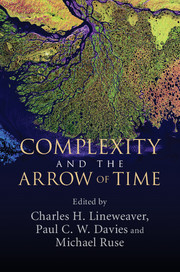Book contents
- Frontmatter
- Contents
- Author biographies
- Part I Introduction
- Part II Cosmological and physical perspectives
- Part III Biological complexity, evolution, and information
- 7 Life: the final frontier for complexity?
- 8 Evolution beyond Newton, Darwin, and entailing law: the origin of complexity in the evolving biosphere
- 9 Emergent order in processes: the interplay of complexity, robustness, correlation, and hierarchy in the biosphere
- 10 The inferential evolution of biological complexity: forgetting nature by learning to nurture
- 11 Information width: a way for the second law to increase complexity
- Part IV Philosophical perspectives
- Index
- References
10 - The inferential evolution of biological complexity: forgetting nature by learning to nurture
from Part III - Biological complexity, evolution, and information
Published online by Cambridge University Press: 05 July 2013
- Frontmatter
- Contents
- Author biographies
- Part I Introduction
- Part II Cosmological and physical perspectives
- Part III Biological complexity, evolution, and information
- 7 Life: the final frontier for complexity?
- 8 Evolution beyond Newton, Darwin, and entailing law: the origin of complexity in the evolving biosphere
- 9 Emergent order in processes: the interplay of complexity, robustness, correlation, and hierarchy in the biosphere
- 10 The inferential evolution of biological complexity: forgetting nature by learning to nurture
- 11 Information width: a way for the second law to increase complexity
- Part IV Philosophical perspectives
- Index
- References
Summary
Even the recognition of an individual whom we see every day is only possible as the result of an abstract idea of him formed by generalization from his appearances in the past.
James G. FrazerI don't paint things. I only paint the difference between things.
Henri MatisseMathematics is the art of giving the same name to different things.
Henri PoincaréMONDRIAN AND DIRAC ON MINIMALISM
The Dutch painter Piet Mondrian is best known for strikingly simple canvases populated by vertical and horizontal planes rendered in primary colors. Mondrian's paintings from the 1930s: Composition with Yellow Patch, Composition No. 8, and Vertical Composition with Blue and White, are a far cry from his earliest canvases, Landscape with Ditch, Mill in Sunlight, and Red Tree. The early canvases feature colorful and vigorous representations of scenes, and are indebted to the post expressionists, Suerat and Van Gogh. These in time give way to the later compositions influenced by the analytical abstractions of the cubists, Picasso and Braque. The names of the later paintings reveal a parallel trend towards descriptive simplicity. In his correspondence, Mondrian provides a clue to his thought leading to this change of style: “The principle of this art…is not a negation of matter, but a great love of matter, whereby it is seen in the highest, most intense manner possible, and depicted in the artistic creation.” (1912) and “We arrive at a portrayal of other things, such as the laws governing matter. These are the great generalities which do not change.” (1913) (Faerna, 1997). Over the course of the cultural evolution of Mondrian's creative life, we observe a systematic trend away from detail and realism and towards minimalism and abstraction. Painterly subjects easily recognized in his early canvases become a kind of affine symbolism in the later paintings.
Information
- Type
- Chapter
- Information
- Complexity and the Arrow of Time , pp. 224 - 245Publisher: Cambridge University PressPrint publication year: 2013
References
Accessibility standard: Unknown
Why this information is here
This section outlines the accessibility features of this content - including support for screen readers, full keyboard navigation and high-contrast display options. This may not be relevant for you.Accessibility Information
- 1
- Cited by
